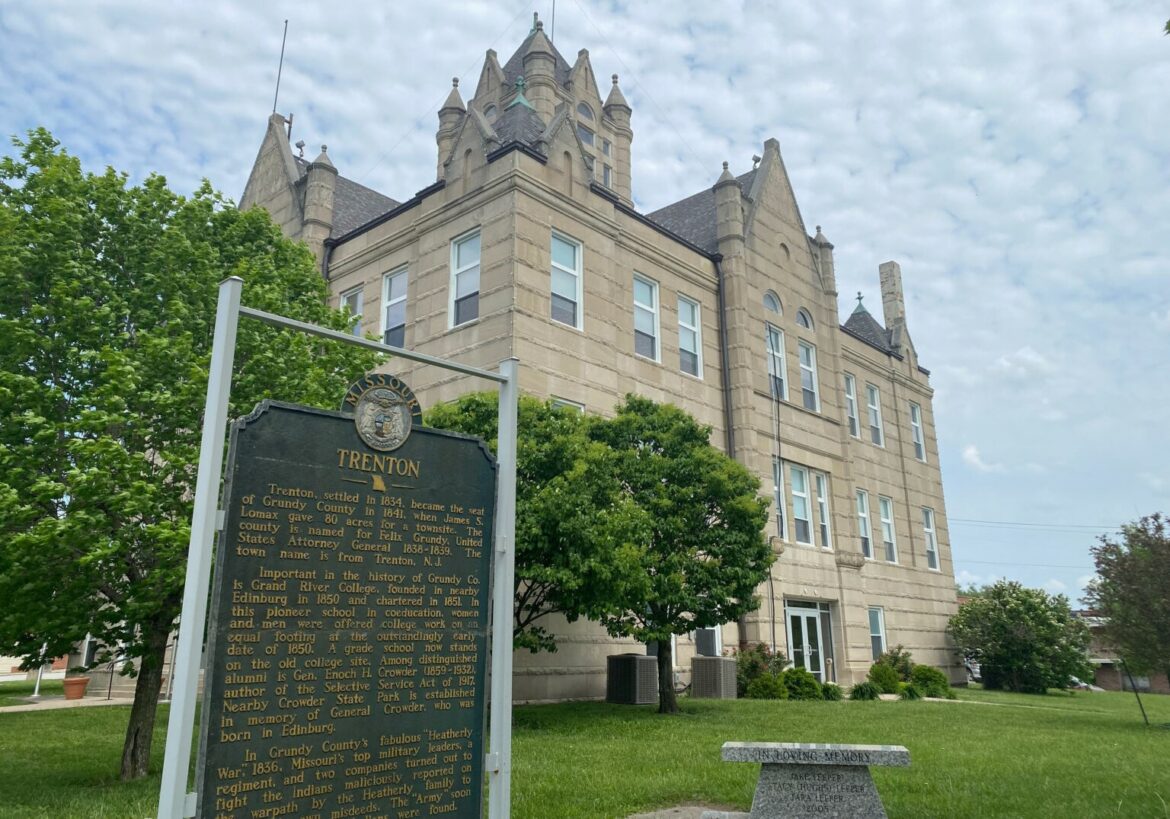‘Time Bomb’ Lead Pipes Set to be Removed. But First Water Utilities Have to Find Them Hidden Health Threat
Published June 20th, 2022 at 9:34 AM
Above image credit: An individual holds a lead pipe, a steel pipe and a lead pipe treated with protective orthophosphate. The Environmental Protection Agency is only now requiring water systems to inventory their lead pipes decades after new ones were banned (Courtesy | EPA).TRENTON, Missouri — It took three years for officials to notice lead was seeping into the city’s drinking water.
Missouri regulators had given the green light in 2014 for Trenton to start adding monochloramine to its drinking water to disinfect it without the harmful byproducts of chlorine.
But by 2017, the city noticed something alarming.
Lead levels in drinking water in the northwest Missouri town — population 5,609 — had spiked.
Over the next two years, one-quarter of the homes tested exceeded the Environmental Protection Agency’s action level — 15 parts per billion — at least once.
The culprit, city and state officials believe, was the monochloramine. It likely corroded old lead pipes and caused the surge of lead in the drinking water. Because it hadn’t detected high levels of lead in years past, Trenton hadn’t been required to test for lead at residents’ taps since 2014.

Until the city got test results, “we just thought maybe it was kind of like an isolated spot,” said Ron Urton, the city administrator and utility director. “And then once we did the test and saw there was other elevated places, that’s when we started, I think, kind of figuring out what was going on.”
The 62 homes Trenton tested during that period have lead pipes, or service lines, running from the water mains, Urton said. But beyond that, very little is known about where lead pipes remain in the system with about 3,000 water meters.
Trenton has managed to get its lead levels back down again by adding a compound that reduces corrosion. But, experts say, the only permanent solution to stop lead from seeping into Americans’ water is to remove the millions of lead pipes that remain 36 years after environmental regulators banned new ones from being installed.
Therein lies the problem.
Trenton — like many other water systems — doesn’t know where all of its lead service lines are.
State governments have only a fraction of the picture.
And while President Joe Biden has prioritized removing remaining lead service lines, water utilities aren’t required to finish finding them for almost two and a half years.
“One the biggest problems we have is we don’t know where these lead pipes are oftentimes,” said Marc Edwards, a distinguished professor at Virginia Tech who helped blow the whistle on the lead crisis in Flint, Michigan, which began in 2014.
New lead pipes were banned at the federal level in 1986, and states came into compliance in the three years following. Water utilities have never been required to thoroughly inventory their lead pipes before a crisis. And only in rare instances are they required to replace them under the EPA’s lead and copper rule.
“A lot of people are flabbergasted that no one’s even bothered to try to figure out how many lead service lines there are in their community or in their state,” said Erik Olson, a senior strategic director for the Natural Resources Defense Council.
Lead is a dangerous neurotoxin that poisons thousands of kids each year in Missouri, Kansas, Iowa and Nebraska. The heavy metal was used for most of the 20th century in pipes, paint, gasoline and other household products.

Since lead was phased out of gasoline and prohibited from new pipes and paint, lead poisoning among children has plummeted. But the U.S. has not historically mandated widespread eradication of lead paint and pipes, so the danger remains, especially in the homes of poor and minority families.
Water is estimated to make up about 20% of a child’s lead exposure, according to the EPA. Fetuses and bottle-fed infants are at greatest risk for exposure to lead-tainted water, Edwards said. For toddlers and children, lead paint and dust are the leading causes of exposure.
Not every American with a lead service line is continuously drinking high levels of lead. Utilities use treatments, like orthophosphate, that keep water from corroding the lead pipes and drawing out the toxic metal.
But changes in the water chemistry, like that in Trenton, or construction that shakes up a lead pipe, can suddenly cause a problem, Edwards said.
“Those pipes are a time bomb,” he said. “They could go off at any time.”
Undetected Lead
Monochloramine is used to disinfect drinking water as it travels through pipes, and it has fewer potentially harmful byproducts than chlorine, its predecessor.
But while chlorine keeps lead service lines from leaching, monochloramine does the opposite, Edwards said. It’s corrosive and can cause lead to enter the water as it travels to homes.
Washington, D.C., switched from chlorine to monochloramine in 2000, and the number of babies with elevated blood lead levels rose nearly tenfold in a few months and remained four times higher than before the crisis for the following couple of years, according to a study Edwards published in Environmental Science and Technology. In a separate study, he estimated that fetal deaths rose between 32% and 63%.
After that disaster, utilities should have understood they need to control for corrosion when making such a switch, Edwards said, but “we don’t learn from our mistakes.”
“You can’t just switch it and do this toxicological experiment on the general population and wait and see,” Edwards said.
Every year he sees a handful of utilities switch to monochloramine and spark a lead problem, Edwards said, which he thinks is the “tip of the iceberg.”
“This is still happening when it shouldn’t,” Edwards said.
In a statement, Brian Quinn, a spokesman for the Missouri Department of Natural Resources, said the state has not typically seen issues arise when utilities switch from chlorine to monochloramine. But a staffer attended an EPA training in 2017 where the Washington, D.C., case was presented. Now, the state requires increased monitoring for any systems that change the source or treatment of their water.
Mona Hanna-Attisha, a pediatrician whose research helped expose the Flint water crisis, said situations like Trenton underscore the importance of removing lead service lines, even if they’re not causing a known problem today.
“Flint’s water crisis wasn’t the first, it wasn’t the worst and it wasn’t the last,” she said. “These kinds of things continue to happen unseen throughout the country.”

It’s difficult, though, to say how significantly the spike in leaded water might have affected the children of Trenton because the population is so small.
In each of the two years before Trenton made the switch to monochloramine, fewer than five children in the ZIP code spanning the town had blood lead levels above 5 micrograms per deciliter, which, at the time, was the Centers for Disease Control and Prevention’s reference value.
When the number of tests is that low, the Missouri Department of Health and Senior Services withholds data to avoid identifying children. So the exact number of children found to be lead poisoned in those years is not publicly known.
In 2014, it climbed to eight — then 13 in 2015 and 20 in 2016.
In 2017, it fell to eight and then to five or fewer starting in 2018.
Edwards said when monochloramine is added to water, the most severe lead leaching happens in the year or two that follow. That means Trenton wasn’t testing its water when it may have had its highest concentrations of lead.
After Trenton discovered the lead in its water, it treated it to stop the corrosion and its lead levels fell back below the EPA limits.
Where Are the Pipes?
Missouri is expected to receive $250 million over the next five years for lead service line replacement. Kansas will get $164 million, Nebraska will receive $142 million and Iowa will get $225 million.
But first, utilities have to identify where those lead lines are.
Data collected by Kansas, Missouri, Iowa and Nebraska under America’s Water Infrastructure Act of 2018 reflects almost 194,000 service lines made from lead or using lead connectors across the four states. But only a fraction of utilities were required to complete those surveys.
A study based on two voluntary industry surveys from 2011 and 2013 estimates those four states have 747,000 lead service lines, some of the most per capita in the country.
“We don’t have an estimate or a ballpark, but we do know that we have thousands of them in Iowa,” said Mark Moeller, supervisor of the water supply engineering section with the Iowa Department of Natural Resources.
Jeff Pinson, inorganics unit monitoring chief for the Missouri Department of Natural Resources, said utilities know quite a bit about the remaining lead service lines. But he said the state doesn’t know how many there are.
Until the inventory gets underway, it’s hard to say how many lead service lines might be remaining in Nebraska, said Jessica Johnson, an environmental specialist with the Nebraska Department of Environment and Energy who implements the Safe Drinking Water Act in the state.
“I would say until the ink is dry and they’re submitted, I wouldn’t want to make any guesses or anything like that,” she said.
The Kansas Department of Health and Environment said it received materials evaluations, used to determine testing sites, starting in 2017. It used those to fill out the surveys under the 2019 law.
“It will be a very big challenge for water systems and KDHE to complete the inventories by the deadline,” Matthew Lara, the agency’s spokesman, said in an email.
The data collected under the 2018 law shows huge numbers of lead service lines in St. Louis — about 50% of the city’s 127,402 hookups. That’s an estimate because St. Louis doesn’t know where the lines are, either.
Des Moines, Iowa, reported about 20,500 lead service lines in the same survey.
In Omaha, Nebraska, and surrounding areas, about 12,500 customers of Metropolitan Utilities District get their water through lead service lines, the utility says. Another 26,000 are unknown, and the utility estimates about 5,000 or fewer could be lead.
Lincoln, Nebraska, estimated it had 2,200 lead pipes and 3,400 non-lead pipes with lead connectors after the 2018 law. The utility says it doesn’t know where they all are and there could be more. It hired a national firm to assist in its inventory.
Cedar Rapids, Iowa, officials say they are “working toward a precise understanding” of where their lead lines are located. The city doesn’t have precise data, but estimates 7,000 or fewer of its approximately 54,000 service lines are made of lead.
Kansas City, Missouri, says there are no more known lead pipes that it’s responsible for, but says it doesn’t know what materials are on the customer-owned end of the line.
Charlie Stevens, utility operations officer for KC Water, said the city’s only information on remaining lead service lines is a list of 128 remaining pipes from the 1980s. The utility believes those pipes have been removed, Stevens said. But the only information confirming that is “hearsay,” he said, from a former lab manager for the utility.
KC Water said it has 159,804 service lines without lead and 16,050 of unknown materials.
Stevens said Kansas City only does work on its portion of the service line, from the water main to the curb. That means it may have replaced portions of lead service lines and left the remainder in the ground.
Experts, including an EPA advisory board, say replacing part of a lead service line does not reliably reduce lead levels in drinking water — and may even worsen contamination in the short-term because sawing off and shaking the pipe can release more of the metal.
Asked if that was an issue Kansas City has ever experienced or been concerned about, Stevens said no.
Many utilities claim responsibility for the portion of the service line running from a water main to the property line or curb stop. They say the customer is responsible for the rest.
That’s the policy in Trenton.
“There’s a little bit of responsibility on the property owners, I think, too,” said Urton, the city administrator.
Olson disputes that.
“In so many locations across the country, the water utilities say, ‘We don’t own all of the service line,’ or, ‘We only own a little part of it, and the homeowner is responsible for the rest,’” Olson said. “And in so many cases that is not at all clear legally.”
A new EPA rule requiring utilities to inventory their lead service line says they have to account for the whole thing.
Utilities on both sides of the state line in Kansas City say they have no lead service lines on their end — but they can’t account for the customer portion of the line.
WaterOne serves most of Johnson County, Kansas, in suburban Kansas City. It says it has no lead in its distribution system and sent comments to EPA opposing the requirement to inventory lead service lines.
“The requirement of a lead service line inventory puts WaterOne in the complex situation of proving a negative of what we already know to be true — the absence of lead in (the) utility-owned side of the water supply system,” the utility’s letter says.
Cities and states are still waiting for more guidance from the EPA to give water utilities on best practices for locating lead pipes.
‘Underground Poisonous Straws’
Tallying the toll of lead-contaminated water on a community is difficult, said Bruce Lanphear, a lead researcher and professor at Simon Fraser University in Vancouver, Canada.
At levels like those measured in Trenton, the impact isn’t immediately obvious.
“Because people don’t keel over immediately, we don’t treat it as an urgent problem,” Lanphear said.
At a population level, he said, a pregnant woman being exposed to high levels of lead might increase the chance of a pre-term birth or miscarriage.
“But for preterm birth, we don’t see lead. We just say it just happens,” Lanphear said. “So, that’s the dilemma is that it’s insidious.”

Beyond that, Edwards said screening programs aren’t designed to target children who are most at risk of exposure to lead-contaminated water.
Monitoring programs typically target toddlers, who are at risk of exposure to lead paint because they’re crawling and putting things in their mouth. But fetuses and infants using formula are at the greatest risk when it comes to lead in water.
Edwards said health departments are prone to assuming the water is not a risk because the utility should be monitoring for lead.
“And so no one is testing the age group most likely to show the health harm,” he said.
Lanphear said it’s frustrating, but not surprising, that state governments don’t have a handle on where the lead pipes remain.
“We really, in so many ways, ignored the most basic public health infrastructure,” Lanphear said, while emphasizing expensive cures and profitable technological advancements.
“We’ve neglected things that are basic to health, like clean water, clean air, food that’s not contaminated by lead and other chemicals.”
Situations like that in Trenton, Hanna-Attisha said, are a wake-up call that “we fail to listen to science, that we fail to protect children.” She said it’s a reminder that the Biden administration’s infrastructure package is important to find these “underground poisonous straws.”
“We continue to dull the potential of so many children by not addressing this issue,” she said.
But she said there’s hope now.
“The infrastructure act is the largest federal investment in water infrastructure,” she said, “the largest federal investment in lead in water elimination ever. It’s not all the money, but it’s a lot of money that will finally, hopefully kind of address this long-standing issue.”
Allison Kite is a data reporter for the Missouri Independent, where this story first appeared, with a focus on the environment and agriculture. This is part of Unleaded, a joint investigation by The Missouri Independent and the Midwest Newsroom.




